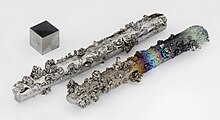Silver Tarnishes Physical Or Chemical

Tungsten rods with evaporated crystals, partially oxidized with colorful tarnish
Tarnish is a thin layer of corrosion that forms over copper, contumely, aluminum, magnesium, neodymium and other like metals as their outermost layer undergoes a chemical reaction. Tarnish does not ever result from the sole effects of oxygen in the air. For case, silver needs hydrogen sulfide to tarnish, although information technology may tarnish with oxygen over time. It oft appears as a ho-hum, gray or blackness motion-picture show or coating over metal. Tarnish is a surface phenomenon that is self-limiting, unlike rust. Only the top few layers of the metallic react, and the layer of tarnish seals protects the underlying layers from reacting.
Tarnish actually preserves the underlying metallic in outdoor use, and in this form is called patina. The formation of patina is necessary in applications such as copper roofing, and outdoor copper, bronze, and brass statues and fittings. Patina is the proper noun given to tarnish on copper-based metals, while toning is a term for the blazon of tarnish which forms on coins.
Chemistry [edit]

A Morgan dollar demonstrating a colourful form of toning on its reverse. While tarnishing on other metal objects is mostly cleaned off, some toning on coins may be considered aesthetically pleasing or benign to the money's value, and is therefore kept in situ.[1]
Tarnish is a product of a chemic reaction between a metal and a nonmetal compound, especially oxygen and sulfur dioxide. It is usually a metallic oxide, the product of oxidation. Sometimes information technology is a metal sulfide. The metal oxide sometimes reacts with water to make the hydroxide; and carbon dioxide to make the carbonate. It is a chemical change. There are diverse methods to foreclose metals from tarnishing.
Prevention and removal [edit]
Using a sparse glaze of smoothen can foreclose tarnish from forming over these metals. Tarnish can be removed by using steel wool, sandpaper, emery paper, baking soda or a file to rub or polish the metal'due south dull surface. Fine objects (such as silverware) may have the tarnish electrochemically reversed (non-destructively) by resting the objects on a piece of aluminium foil in a pot of boiling water with a small corporeality of salt or baking soda,[ii] [3] or it may exist removed with a special polishing compound and a soft fabric. Gentler abrasives, like calcium carbonate, are often used by museums to make clean tarnished silver equally they cannot damage or scratch the silvery and will not go out unwanted residues.[four]
References [edit]
- ^ Bucki, James. "Coin Toning: Definition, Word and Result on Value". The Spruce Crafts . Retrieved i April 2019.
- ^ "Finishing techniques in Metalwork". philamuseum.org. Philadelphia Museum of Fine art.
- ^ "Remove Tarnish from Silver". scifun.chem.wisc.edu. Department of Chemistry, University of Wisconsin-Madison. Retrieved 2012-x-19 .
- ^ "Making information technology Shine". ohiohistory.wordpress.com. Ohio Historical Society. 2011-06-02. Archived from the original on 2012-03-23. Retrieved 2012-10-19 .
External links [edit]
- Herman Argent Restoration, Conservation & Preservation
- Common causes of gold tarnishing & prevention
Silver Tarnishes Physical Or Chemical,
Source: https://en.wikipedia.org/wiki/Tarnish
Posted by: pipesglikeltas.blogspot.com


0 Response to "Silver Tarnishes Physical Or Chemical"
Post a Comment